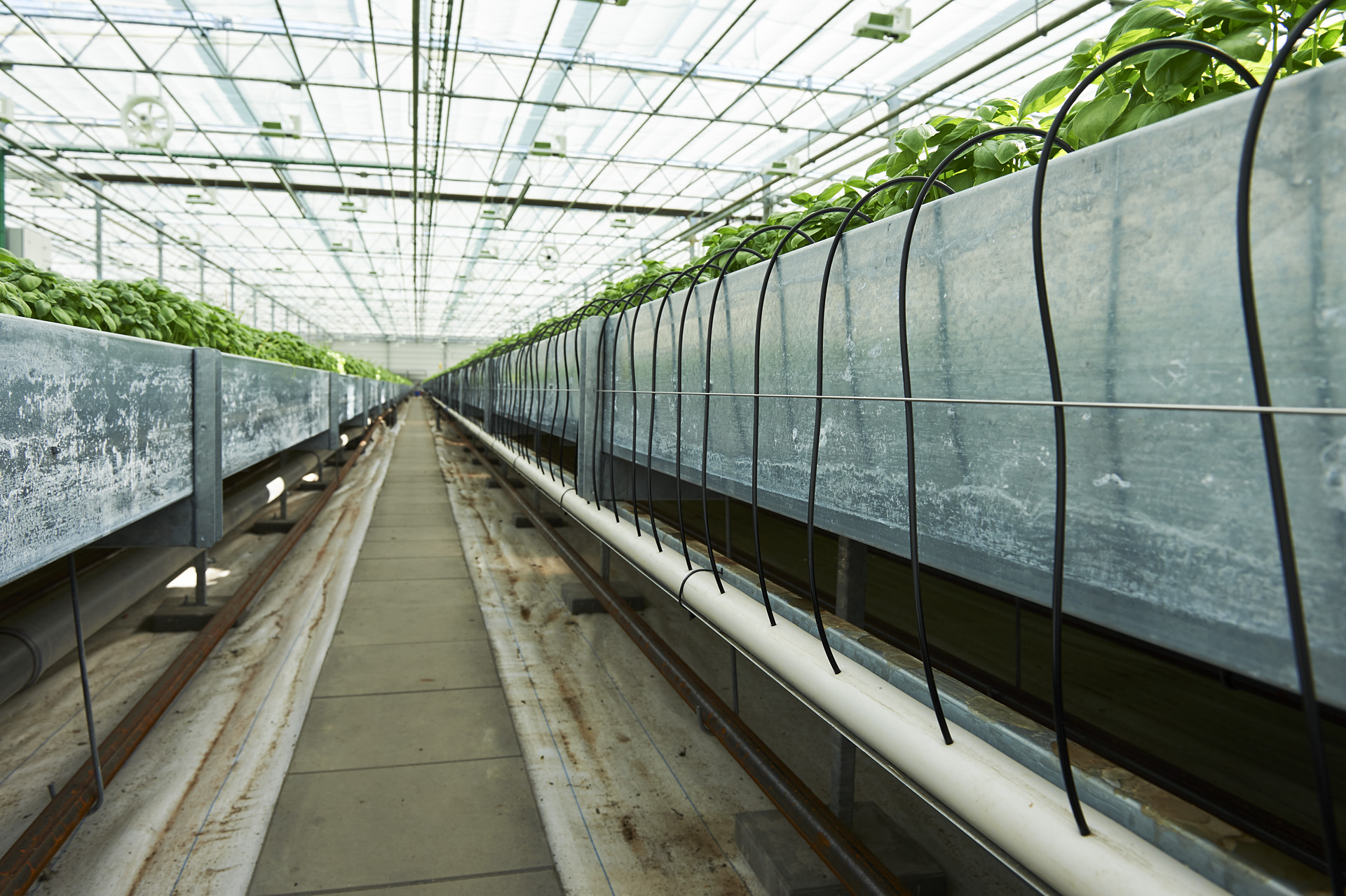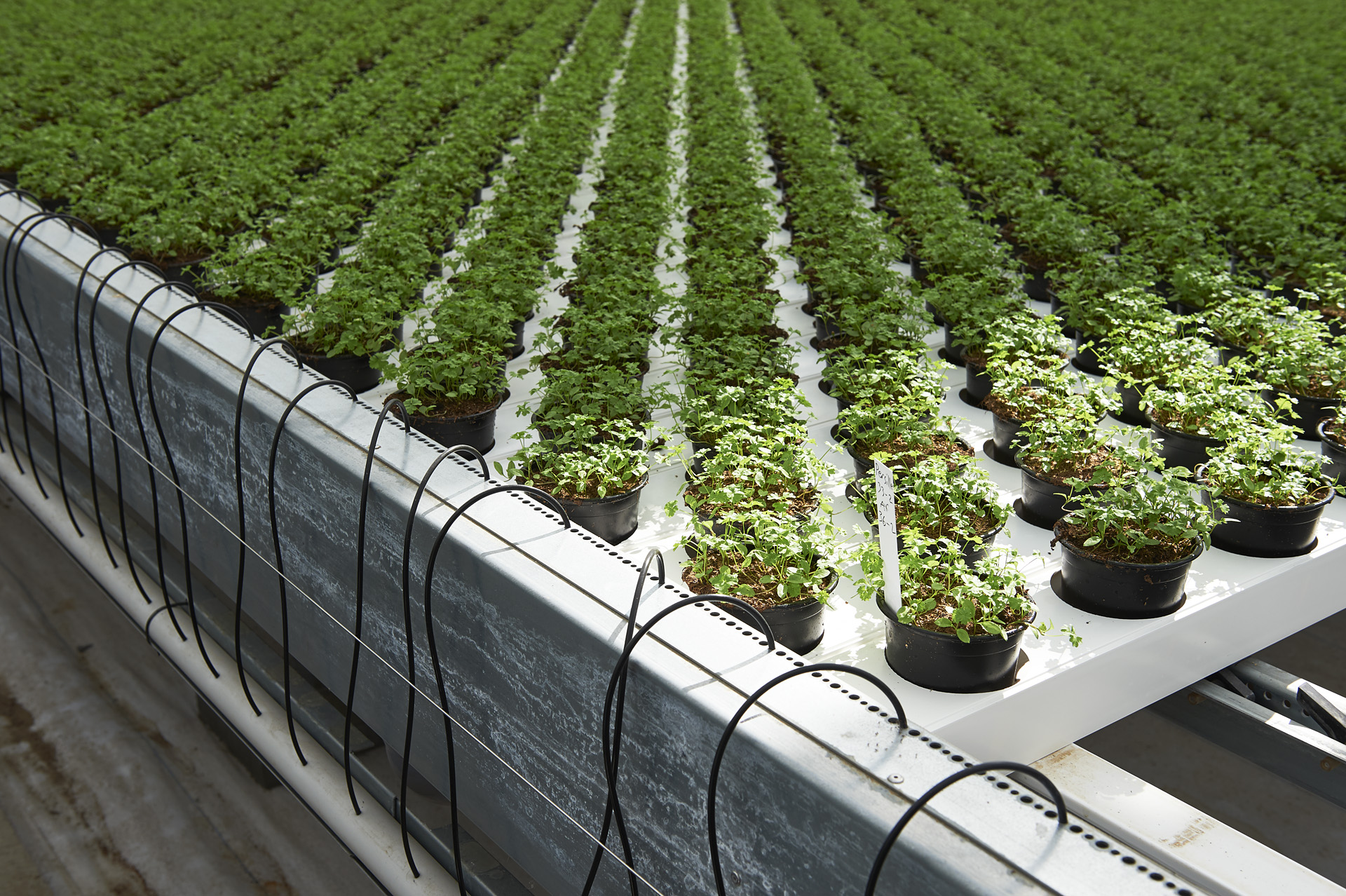Effective Water Conservation Strategies for Indoor Farming
Water covers 71 % of Earth’s surface, but only 3 % is suitable for drinking and farming. Moreover, water consumption is rising at more than twice the rate of population growth. Hence, it’s vital to conserve water in indoor farming.
At Viemose DGS, we utilize various methods that greatly enhance the water-saving efficiency of our systems. Below are a few of the numerous strategies we employ in our Moving Gutter System and Vertical Farming System to optimize water conservation.

Hydroponic System – Nutrient Film Technique
At Viemose DGS, we utilize the Nutrient Film Technique (NFT) in our indoor farming systems. Water usage in a hydroponic system utilizing the Nutrient Film Technique involves implementing various strategies such as:
Precision irrigation, water recycling and filtration, optimizing nutrient solution concentration, proper plant selection, and extensive monitoring and optimization. Below we will explain each strategy and its advantages:
Smart Irrigation Systems for Water Conservation
Implementing sensors and automation technology helps optimize irrigation schedules based on plant needs, weather conditions, and soil moisture levels. These systems can prevent overwatering and ensure water is only applied when necessary.
Our systems are capable of employing both drip irrigation and mist irrigation tailored to the specific requirements of your indoor farming operation.
Drip Irrigation vs. Mist Irrigation
Choosing between drip and mist irrigation systems depends on factors such as crop type, greenhouse climate, and budget considerations.
Drip irrigation efficiently delivers water directly to plant roots, making it ideal for moisture-sensitive crops like tomatoes or cucumbers. Although it requires an initial investment in drip lines and emitters, it offers long-term savings on water and labor costs, making it best suited for crops with deep root systems that require uniform moisture distribution.
On the other hand, mist irrigation produces fine droplets that humidify the greenhouse environment and cool plants during hot periods, benefiting humidity-sensitive crops such as lettuce or herbs. While initial setup costs may be higher due to misting equipment, mist systems provide advantages in climate control and disease prevention, particularly for crops requiring high humidity levels or foliar nutrient application.
Water Recycling and Filtration
In a Nutrient Film Technique (NFT) setup such as ours, water recycling and filtration are essential components of the system’s design aimed at maximizing efficiency and sustainability.
Water recycling involves capturing and reusing water that has been used to nourish the plants. Instead of allowing the water to be lost through runoff, it is collected and returned to the reservoir for reuse. This closed-loop system minimizes water waste and ensures that the system operates with minimal water inputs.
Filtration is necessary to maintain water quality within the system. As water is recirculated, it can accumulate debris, sediment, and potentially harmful pathogens. Filtration systems remove these contaminants, ensuring that the water remains clean and suitable for plant growth. By keeping the water clean, filtration helps prevent clogs in the system’s tubing and ensures that the nutrient solution delivered to the plants is free from impurities.
Optimized Plant Nutrition for Water Conservation in Indoor Farming
Optimizing plant nutrition within a Nutrient Film Technique (NFT) system plays a vital role in water usage efforts for several reasons.
Firstly, providing plants with the appropriate balance of essential nutrients directly to their roots in an NFT system ensures efficient nutrient uptake. This means that plants are better able to utilize the nutrients available to them, reducing the need for excess fertilizers that could potentially leach into the surrounding environment or be wasted through runoff.
Furthermore, when plants receive optimal nutrition, they are healthier and more resilient against stressors such as drought. Healthy plants are generally more efficient in their use of water, as they can regulate their water uptake more effectively and are less prone to water stress. This can lead to overall reduced water consumption within the system.
Choosing Water-Efficient Crops
One aspect of choosing water-efficient crops involves considering their natural drought tolerance. Some crop varieties have evolved mechanisms to withstand periods of water scarcity more effectively than others.
These drought-tolerant crops typically have adaptations such as deep root systems, which enable them to access water from deeper soil layers, or specialized mechanisms for water retention within their tissues. By selecting such crops, indoor farmers can reduce the need for frequent watering and irrigation, thereby conserving water resources.
Crops with shallow root systems require less water as they primarily absorb moisture from the top layers of soil or growing media. These crops are better suited for environments where water availability may be limited or where irrigation practices aim to minimize water usage in indoor farming.

Monitoring Water Usage in Indoor Farming
Based on the data collected through monitoring, growers can make adjustments to optimize water usage and promote water conservation. This may involve fine-tuning irrigation schedules to match the specific water needs of different crops and growth stages.
For example, adjusting the frequency and duration of nutrient solution delivery based on factors such as ambient temperature, humidity levels, and plant growth rates can help minimize water wastage while ensuring optimal plant hydration.
Viemose DGS remains Committed to Enhancing Water Efficiency in Indoor Farming
Water usage in indoor farming plays a pivotal role in ensuring a resilient future for farming. As water resources become increasingly strained, it becomes imperative to adopt efficient water management practices to mitigate the impacts of water scarcity and ensure the long-term viability of food production.
At Viemose DGS, we understand the critical importance of prioritizing water conservation in indoor farming. Therefore, we maintain a strong dedication to implementing innovative strategies to improve water-saving efficiency in our Moving Gutter System and Vertical Farming System.
FAQs on Water Conservation in Indoor Farming
How does Viemose DGS utilize smart irrigation systems in their indoor farming practices, and what advantages do these systems offer?
We incorporate sensors and automation technology in our smart irrigation systems for indoor farming. These systems analyze plant needs, weather conditions, and soil moisture levels to optimize irrigation schedules, preventing overwatering and ensuring water is applied only when necessary.
The advantages include reduced water wastage, improved plant health, and enhanced resource efficiency.
Could you elaborate on the criteria Viemose DGS considers when selecting water-efficient crops for their indoor farming systems?
When selecting water-efficient crops for indoor farming, Viemose DGS considers various factors such as natural drought tolerance, root system architecture, and water retention capabilities.
We prioritize crops with adaptations for water conservation, such as deep root systems or mechanisms for water retention within tissues. By choosing such crops, we aim to minimize water usage and promote efficient cultivation practices.
What are some potential challenges or drawbacks associated with implementing water recycling and filtration systems in indoor farming operations?
Potential challenges associated with implementing water recycling and filtration systems in indoor farming operations include initial setup costs, maintenance requirements, and the risk of system malfunctions.
Additionally, ensuring proper filtration and water quality may be essential to prevent clogs in the system’s tubing and maintain the health of plants. Despite these challenges, effective water recycling and filtration systems can significantly contribute to water conservation and efficiency in indoor farming.





